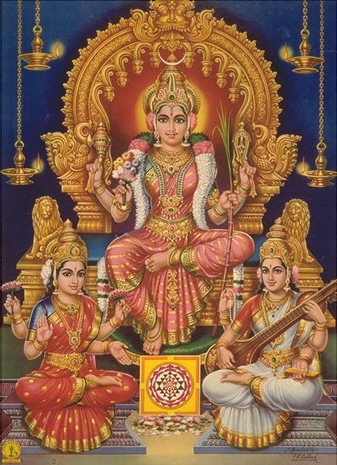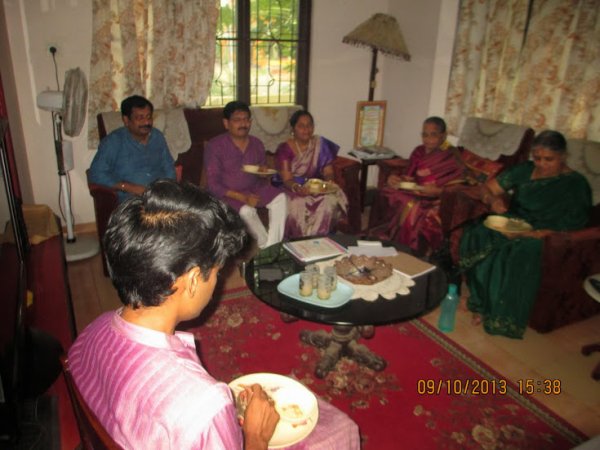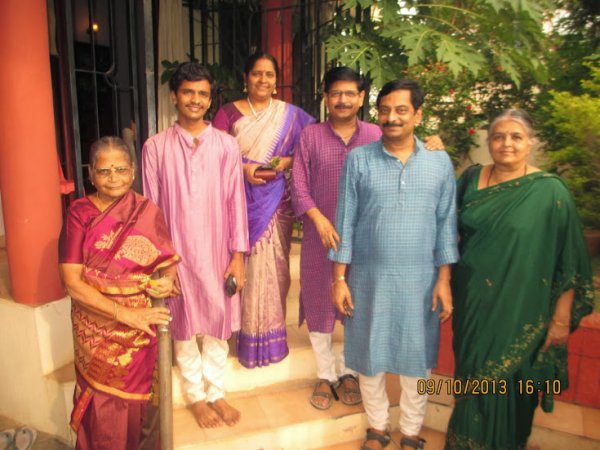P.J.
0
Navarathri ,Golu Essential Details.
Navaratri
Navratri in 2015.
Navratri Day 1 – October 13, 2015 – Ghatsthapana – Navratri Begins
Navratri Day 2 – October 14, 2015 – Chandra Darshan (Tithi is repeated)
Navratri Day 2 – October 15, 2015 – Sindoor Tritiya
Navratri Day 3 – October 16, 2015 – Varad Vinayak Chaturthi
Navratri Day 4 – October 17, 2015 – Upang Lalita Vrat – Lalitha Panchami
Navratri Day 5 – October 18, 2015 – Saraswati Awahan
Navratri Day 6 – October 19, 2015 – Saraswathi Puja (western parts of India)
Navratri Day 7 – October 20, 2015 – Saraswathi Balidan – Maha Lakshmi Puja (western parts of India)
Navratri Day 8 – October 21, 2015 – Mahashtami – Annapoorna Parikrama – Saraswati Visarjan
Navratri Day 9 and 10 – October 22, 2015 – Mahanavami and Dasami. The tenth day is celebrated as Dasara or Vijaya Dashami.
Note – Navratri day 9 and 10 are marked on same date in many calendars.
South India
In South India, Goddess Durga is worshipped during the first three days.
Goddess Lakshmi is worshipped during the next three days
Goddess Saraswathi is worshipped during the last three days.
The Navratri commences on the first day (pratipada) of the bright fortnight of the lunar month of Ashwin. The festival is celebrated for nine nights once every year during the beginning of October, although as the dates of the festival are determined according to the lunar calendar, the festival may be held for a day more or a day less.

Durga Lakshmi Saraswathi.jpg.
The Five Navaratri.
Navarathri is celebrated five times a year. They are Vasanta Navaratri, Ashadha Navaratri, the Sharada Navaratri, and the Paush/Magha Navaratri. Of these, the Sharada Navaratri of the month of Puratashi and the Vasanta Navaratri of the Vasanta kala are very important.
1. Vasanta Navaratri: Basanta Navaratri, also known as Vasant Navaratri, is the festival of nine days dedicated to the nine forms of Shakti (Mother Goddess) in the spring season (March–April). It is also known as Chaitra Navaratri. The nine days of festival is also known as Raama Navratri.
2. Gupta Navaratri: Gupta Navaratri, also referred as Ashadha or Gayatri or Shakambhari Navaratri, is nine days dedicated to the nine forms of Shakti (Mother Goddess) in the month of Ashadha (June–July). Gupta Navaratri is observed during the Ashadha Shukla Paksha (waxing phase of moon).
3. Sharada Navaratri: This is the most important of the Navaratris. It is simply called Maha Navaratri (the Great Navratri) and is celebrated in the month of Ashvina. Also known as Sharad Navaratri, as it is celebrated during Sharad (beginning of winter, September–October).
4. Paush Navaratri: Paush Navaratri is nine days dedicated to the nine forms of Shakti (Mother Goddess) in the month of Paush (December–January). Paush Navaratri is observed during the Paush Shukla Paksha (waxing phase of moon).
5. Magha Navaratri: Magha Navaratri, also referred as Gupta Navaratri, is nine days dedicated to the nine forms of Shakti (Mother Goddess) in the month of Magha (January–February). Magha Navaratri is observed during the Magha Shukla Paksha (waxing phase of moon).
Navaratri
Navratri in 2015.
Navratri Day 1 – October 13, 2015 – Ghatsthapana – Navratri Begins
Navratri Day 2 – October 14, 2015 – Chandra Darshan (Tithi is repeated)
Navratri Day 2 – October 15, 2015 – Sindoor Tritiya
Navratri Day 3 – October 16, 2015 – Varad Vinayak Chaturthi
Navratri Day 4 – October 17, 2015 – Upang Lalita Vrat – Lalitha Panchami
Navratri Day 5 – October 18, 2015 – Saraswati Awahan
Navratri Day 6 – October 19, 2015 – Saraswathi Puja (western parts of India)
Navratri Day 7 – October 20, 2015 – Saraswathi Balidan – Maha Lakshmi Puja (western parts of India)
Navratri Day 8 – October 21, 2015 – Mahashtami – Annapoorna Parikrama – Saraswati Visarjan
Navratri Day 9 and 10 – October 22, 2015 – Mahanavami and Dasami. The tenth day is celebrated as Dasara or Vijaya Dashami.
Note – Navratri day 9 and 10 are marked on same date in many calendars.
South India
In South India, Goddess Durga is worshipped during the first three days.
Goddess Lakshmi is worshipped during the next three days
Goddess Saraswathi is worshipped during the last three days.
The Navratri commences on the first day (pratipada) of the bright fortnight of the lunar month of Ashwin. The festival is celebrated for nine nights once every year during the beginning of October, although as the dates of the festival are determined according to the lunar calendar, the festival may be held for a day more or a day less.

Durga Lakshmi Saraswathi.jpg.
The Five Navaratri.
Navarathri is celebrated five times a year. They are Vasanta Navaratri, Ashadha Navaratri, the Sharada Navaratri, and the Paush/Magha Navaratri. Of these, the Sharada Navaratri of the month of Puratashi and the Vasanta Navaratri of the Vasanta kala are very important.
1. Vasanta Navaratri: Basanta Navaratri, also known as Vasant Navaratri, is the festival of nine days dedicated to the nine forms of Shakti (Mother Goddess) in the spring season (March–April). It is also known as Chaitra Navaratri. The nine days of festival is also known as Raama Navratri.
2. Gupta Navaratri: Gupta Navaratri, also referred as Ashadha or Gayatri or Shakambhari Navaratri, is nine days dedicated to the nine forms of Shakti (Mother Goddess) in the month of Ashadha (June–July). Gupta Navaratri is observed during the Ashadha Shukla Paksha (waxing phase of moon).
3. Sharada Navaratri: This is the most important of the Navaratris. It is simply called Maha Navaratri (the Great Navratri) and is celebrated in the month of Ashvina. Also known as Sharad Navaratri, as it is celebrated during Sharad (beginning of winter, September–October).
4. Paush Navaratri: Paush Navaratri is nine days dedicated to the nine forms of Shakti (Mother Goddess) in the month of Paush (December–January). Paush Navaratri is observed during the Paush Shukla Paksha (waxing phase of moon).
5. Magha Navaratri: Magha Navaratri, also referred as Gupta Navaratri, is nine days dedicated to the nine forms of Shakti (Mother Goddess) in the month of Magha (January–February). Magha Navaratri is observed during the Magha Shukla Paksha (waxing phase of moon).
- Durga, the inaccessible one
- Bhadrakali
- Amba or Jagadamba, Mother of the universe
- Annapoorna devi, The one who bestows grains (anna) in plenty (purna: used as subjective)
- Sarvamangala, The one who gives joy (mangal) to all (sarva)
- Bhairavi
- Chandika or Chandi
- Lalita
- Bhavani
- Mookambika.
- First three days
The goddess is separated as a spiritual force called Durga also known as Kali in order to destroy all our impurities.
- Second three days
The Mother is adored as a giver of spiritual wealth, Lakshmi, who is considered to have the power of bestowing on her devotees inexhaustible wealth, as she is the goddess of wealth.
Final three days
The final set of three days is spent in worshiping the goddess of wisdom, Saraswati.
In order to have all-round success in life, believers seek the blessings of all three aspects of the divine femininity, hence the nine nights of worship.
Kolu-Golu
.jpg) Golu .
Golu .
During the festival of Navratri in South India, it is customary in the states of Tamil Nadu, Kerala, Andhra Pradesh and Karnataka, as well as in some Tamil communities within Sri Lanka, to display a “Kolu” (also Golu, or Bombe Habba or Bommai Kolu or Bommala Koluvu). This is an exhibition of various dolls and figurines in odd (usually 7, 9, or 11) numbered tiers (“padis”).
When people come to a person’s house to see the Kolu, usually they are given prasad (the offering given to God that day), kumkum and a small bag of gifts. These are only given to girls and married women. In the evenings, a “kuthuvilakku” (small lamp) is lit, in the middle of a decorated “kolam”(Rangoli), before the Kolu and devotional hymns and shlokas are chanted. After performing the puja, the food items that have been prepared are offered to the goddesses.
Kolu is adorned with dolls – predominantly with that of the gods and goddesses depicting mythology. It is a traditional practice to have at least some wooden dolls. There should also be a figurine of a boy and a girl together called ‘Marapacchi’ Bommai.[1] Some photos taken during Kolu of Navratri 2007 & 2010 are displayed at a home situated at Nerul, Navi Mumbai, Maharashtra, India & at a home in Walldorf, Germany respectively are shown below. On the 9th day (Saraswati Puja), special pujas are offered to Goddess Saraswati – the divine source of wisdom and enlightenment. Books and musical instruments are placed in the puja and worshipped as a source of knowledge. Also, tools are placed in the pooja as part of “Ayudha Pooja”. Vehicles are washed and decorated, and puja is performed for them.- The 10th day, “Vijayadasami” – is the most auspicious day of all. It was the day on which evil was finally destroyed by good. It marks a new and prosperous beginning. New ventures started on this day are believed to flourish and bring prosperity. Kids often start tutoring on this day to have a head start in their education.
In the evening of “Vijayadasami”, any one doll from the “Kolu” is symbolically put to sleep and the Kalasam is moved a bit towards North to mark the end of that year’s Navaratri Kolu. Prayers are offered to thank God for the successful completion of that year’s Kolu and with a hope of a successful one the next year. Then the Kolu is dismantled and packed up for the next year.-
Citation.
http://en.wikipedia.org/wiki/Navratri
Related;
https://ramanan50.wordpress.com/2011/09/28/what-is-navaratrihow-to-perform-pooja/


